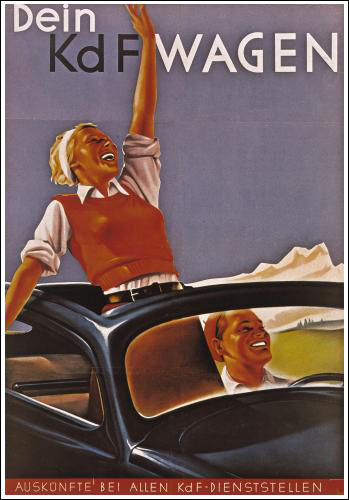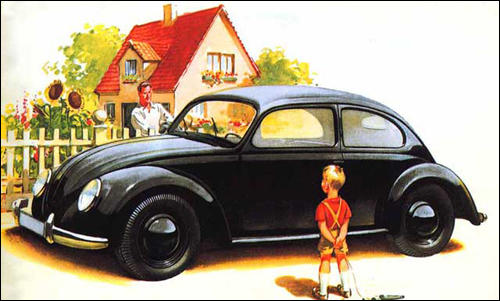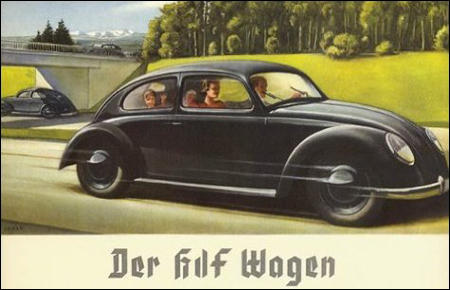Spartacus Blog
Volkswagen and Nazi Germany
Thursday, 1st October, 2015

It was reported yesterday that Volkswagen admitted that almost 1.2m vehicles in the UK are involved in the diesel emissions scandal that has rocked the company, meaning more than one in 10 diesel cars on the country’s roads are affected. There has been much speculation about the damage this scandal has done to the German company. The brand has been severely damaged but it faced a similiar problem in the aftermath of the Second World War.
The story begins when Adolf Hitler was imprisoned in Landsberg Castle in 1924. As a young man Hitler had taken a keen interest in the development of the motor car. One of his early heroes was Henry Ford, who had began production of the Model T in September, 1908. It was a great success and In 1913, the Highland Park Ford Plant became the first automobile production facility in the world to implement the assembly line. Initially it had taken 14 hours to assemble a Model T car. By improving his mass production methods, Ford reduced this to 1 hour 33 minutes. This lowered the overall cost of each car and enabled Ford to undercut the price of other cars on the market. Between 1908 and 1916 the selling price of the Model T fell from $1,000 to $360. It is estimated that by this time 50% of all cars in the world had been made by Fords.
While in prison Hitler read a lot of books. Most of these dealt with German history and political philosophy. Later he was to describe his spell in prison as a "free education at the state's expense." One writer who influenced Hitler while in prison was Henry Ford's autobiography, My Life and Work (1922). It had been translated into German by Curt and Marguerite Thesing. It was one of a small collection of books that was found in his office after his death at Nazi headquarters in May 1945. (1)
Hitler was also influenced by Ford's political views. In 1920 he had published The International Jew. In the article Ford claimed that there was a Jewish conspiracy to take over the world. Ford argued: "The Jew is a race that has no civilization to point to no aspiring religion... no great achievements in any realm... We meet the Jew everywhere where there is no power. And that is where the Jew so habitually... gravitate to the highest places? Who puts him there? What does he do there? In any country, where the Jewish question has come to the forefront as a vital issue, you will discover that the principal cause is the outworking of the Jewish genius to achieve the power of control. Here in the United States is the fact of this remarkable minority attaining in fifty years a degree of control that would be impossible to a ten times larger group of any other race... The finances of the world are in the control of Jews; their decisions and devices are themselves our economic laws." (2)
While in prison Hitler also read an article entitled the Motorization of Germany. It was during this time that Hitler developed the idea that he wanted to be responsible for Germany's Model T. According to Richard Evans, the author of The Third Reich in Power (2005), "by the early 1930s he was drawing rough sketches of a small family vehicle that would sell for less than a thousand Reichsmarks and so be within reach of the vast majority of the population". (3)
Soon after he gained power in 1933 Adolf Hitler announced that the "salvation of the German worker in an enormous and all-embracing attack on unemployment". (4) At the time six million people were registered as unemployed and three million more had disappeared from the employment statistics altogether, many of them women. In 1929 over 20 million had been in work, by the time Hitler took office, that number had fallen to 11.5 million. (5)
Hitler was aware that it was vital to reduce the number of people unemployed if he was to retain power. One of his first decisions was to order the construction of new highways under the direction of Fritz Todt. His goal was a network of 7,300 miles of four-lane highways. Todt calculated that building the motorways would provide employment for 600,000. By June 1935 there were over 125,000 men working on motorway construction. Hitler announced that this road building achievement was "an overture to peace" but was also undertaken to permit the rapid movement of troops in war. Hitler was especially interested in east-west highways in order to meet the demands of a two-front war. (6)
Hitler also wanted to fill these highways with German built motor cars. At that time, there was only one motor-car for every fifty persons (compared to one for every five in America). German people had to use a bicycle or public transportation to get about. Hitler approached leading figures in private industry and demanded they produced an automobile for around $396 (this was the kind of price being paid for cheap cars in America). They said it was impossible and so Hitler decided that they had to be produced by the state. (7)
In 1935 Adolf Hitler announced that the government had plans to produce a "People's Car" (Volkswagen). Hitler gave his drawings of his "beetle car" to Ferdinand Porsche, a man who had become famous for designing racing cars. However, Porsche's prototype design was not ready until the end of 1937. (8)
At Hitler's insistence, the car's production was funded by the German Labour Front as part of its Strength Through Joy scheme. Robert Ley, the movement's leader, was forced to provide 50 million marks in capital to produce the car. On 2nd August, 1938, Ley announced that: "A Volkswagen for every German - let that be our aim. That is what we want to achieve." He also gave details of how workers could obtain this new car. "I herewith proclaim the conditions under which every working person, can acquire an automobile. (i) Each German, without distinction of class, profession, or property can become the purchaser of a Volkswagen. (ii) The minimum weekly payment, insurance included, will be 5 marks. Regular payment of this amount will guarantee, after a period which is yet to be determined, the acquisition of a Volkswagen. The precise period will be determined upon the beginning of production." (9)

In contrast to universal hire-purchase practice, the scheme provided for delivery only after payment of the last installment. William L. Shirer, the author of The Rise and Fall of Nazi Germany (1959) wrote: "Dr Ley's ingenious plan was that the workers themselves should furnish the capital by means of what became known as a 'pay-before-you-get-it' installment plan - five marks a week, or if a worker thought he could afford it, ten or fifteen marks a week. When 750 marks had been paid in, the buyer received an order number entitling him to a car as it could be turned out." (10)
A huge advertising campaign was launched to persuade workers to put aside part of their wages to save up for a Volkswagen, with the slogan "a car for everyone". This was a great success and over 330,000 workers applied to buy a car. In 1938 a factory was built at Fallersleben to produce it. (11)

One German reported: "For a large number of Germans, the announcement of the People's Car is a great and happy surprise.... For a long time the car was a main topic of conversation in all sections of the population in Germany. All other pressing problems, whether of domestic or foreign policy, were pushed into the background for a while. The grey German everyday sank beneath notice under the impression of this music of the future. Wherever the test models of the new Strength-Through-Joy construction are seen in Germany, crowds gather around them. The politician who promises a car for everyone is the man of the masses if the masses believe his promises. And as far as the Strength-Through-Joy car is concerned, the German people do believe in Hitler's promises." (12)
The first completed Volkswagen cars were exhibited at Munich and Vienna at the height of the Sudetenland Crisis in October 1938. (13) Another one was presented to Adolf Hitler at the International Motor Show in Berlin on 17th February 1939. Hitler gave it to his girlfriend Eva Braun as a birthday present. It became known as the "beetle" from the rounded shape Hitler gave it in his original design. (14)
Soon afterwards the Volkswagen factory at Fallersleben stopped making cars. Instead it turned to the manufacture of goods that would be needed by the military in the soon to start Second World War. Not a single car was produced for those 330,000 workers who had paid in their money to the German Labour Front. (15)

During the war the Volkswagen factory produced the Kübelwagen and the amphibious Schwimmwagen. It also produced parts for VI Flying Bombs. (16) Some of the labour force came from the Arbeitsdorf Camp. The company later admitted that it used 15,000 slaves during the war effort. German historians has estimated that 80% of Volkswagen's wartime workforce were supplied by concentration camps. (17)
In the summer of 1945 the British Army took over control of the Volkswagen factory. The original intention was to dismantle the entire production line and ship out the machinery and tooling as reparations. Colonel Charles Radclyffe, who was in charge of car manufacture in the British zone, was responsible for carrying out this plan. However, when the Volkswagen equipment was offered to Britain's motor manufacturers, they turned it down. An official British report found that "the vehicle does not meet the fundamental technical requirement of a motor-car... it is quite unattractive to the average buyer... To build the car commercially would be a completely uneconomic enterprise." (18)
Colonel Radclyffe instructed Major Ivan Hirst of the Royal Electrical and Mechanical Engineers (Reme) to take control of the operation. Hirst managed to find the original plans that were used to build the Volkwagen show models in 1938. (19) "He (Hirst) organised the clearance of bomb damage and had the buildings repaired; he re-commissioned machine tools, body presses and assembly jigs; he concerned himself with improving the quality of the car, with setting up a sales and service network... after one of the few surviving wartime Volkswagen cars had been demonstrated to the British Rhine army group headquarters, the military ordered a batch of 20,000 similar vehicles". (20)
In 1947 Colonel Radclyffe decided that a suitable German must be found to take over the company. It was suggested by Major Hirst that he should recruit Heinrich Nordhoff, who had worked as a production manager at Opel, during the Second World War. Nordhoff was appointed as managing director in January 1949. Over the next 20 years Nordhoff turned Volkswagen into one of the world's leading car manufacturers.
References
(1) Neil Baldwin, Henry Ford and the Jews (2001) page 182
(2) Henry Ford, The International Jew (22nd May, 1920)
(3) Richard Evans, The Third Reich in Power (2005) pages 327
(4) Adolf Hitler, radio broadcast (1st February, 1933)
(5) Richard Evans, The Third Reich in Power (2005) pages 327
(6) Louis L. Snyder, Encyclopedia of the Third Reich (1998) page 284
(7) William L. Shirer, The Rise and Fall of Nazi Germany (1959) pages 330-331
(8) James Taylor and Warren Shaw, Dictionary of the Third Reich (1987) page 297
(9) Robert Ley, statement (2nd August, 1938)
(10) William L. Shirer, The Rise and Fall of Nazi Germany (1959) page 332
(11) James Taylor and Warren Shaw, Dictionary of the Third Reich (1987) page 297
(12) A report by a secret agent working for the Social Democrat Party (April 1939)
(13) Richard Grunberger, A Social History of the Third Reich (1971) page 48
(14) Richard Evans, The Third Reich in Power (2005) pages 327
(15) William L. Shirer, The Rise and Fall of Nazi Germany (1959) pages 330-331
(16) Ray Massey, The Daily Mail (29th November, 2012)
(17) The New York Times (13th June, 1998)
(18) The Guardian (18th March, 2000)
(19) Ray Massey, The Daily Mail (29th November, 2012)
(20) The Guardian (18th March, 2000)
Previous Posts
Anne Boleyn in the history classroom (29th August, 2015)
Why the BBC and the Daily Mail ran a false story on anti-fascist campaigner, Cedric Belfrage (22nd August, 2015)
Women and Politics during the Reign of Henry VIII (14th July, 2015)
The Politics of Austerity (16th June, 2015)
Was Henry FitzRoy, the illegitimate son of Henry VIII, murdered? (31st May, 2015)
The long history of the Daily Mail campaigning against the interests of working people (7th May, 2015)
Nigel Farage would have been hung, drawn and quartered if he lived during the reign of Henry VIII (5th May, 2015)
Was social mobility greater under Henry VIII than it is under David Cameron? (29th April, 2015)
Why it is important to study the life and death of Margaret Cheyney in the history classroom (15th April, 2015)
Is Sir Thomas More one of the 10 worst Britons in History? (6th March, 2015)
Was Henry VIII as bad as Adolf Hitler and Joseph Stalin? (12th February, 2015)
The History of Freedom of Speech (13th January, 2015)
The Christmas Truce Football Game in 1914 (24th December, 2014)
The Anglocentric and Sexist misrepresentation of historical facts in The Imitation Game (2nd December, 2014)
The Secret Files of James Jesus Angleton (12th November, 2014)
Ben Bradlee and the Death of Mary Pinchot Meyer (29th October, 2014)
Yuri Nosenko and the Warren Report (15th October, 2014)
The KGB and Martin Luther King (2nd October, 2014)
The Death of Tomás Harris (24th September, 2014)
Simulations in the Classroom (1st September, 2014)
The KGB and the JFK Assassination (21st August, 2014)
West Ham United and the First World War (4th August, 2014)
The First World War and the War Propaganda Bureau (28th July, 2014)
Interpretations in History (8th July, 2014)
Alger Hiss was not framed by the FBI (17th June, 2014)
Google, Bing and Operation Mockingbird: Part 2 (14th June, 2014)
Google, Bing and Operation Mockingbird: The CIA and Search-Engine Results (10th June, 2014)
The Student as Teacher (7th June, 2014)
Is Wikipedia under the control of political extremists? (23rd May, 2014)
Why MI5 did not want you to know about Ernest Holloway Oldham (6th May, 2014)
The Strange Death of Lev Sedov (16th April, 2014)
Why we will never discover who killed John F. Kennedy (27th March, 2014)
The KGB planned to groom Michael Straight to become President of the United States (20th March, 2014)
The Allied Plot to Kill Lenin (7th March, 2014)
Was Rasputin murdered by MI6? (24th February 2014)
Winston Churchill and Chemical Weapons (11th February, 2014)
Pete Seeger and the Media (1st February 2014)
Should history teachers use Blackadder in the classroom? (15th January 2014)
Why did the intelligence services murder Dr. Stephen Ward? (8th January 2014)
Solomon Northup and 12 Years a Slave (4th January 2014)
The Angel of Auschwitz (6th December 2013)
The Death of John F. Kennedy (23rd November 2013)
Adolf Hitler and Women (22nd November 2013)
New Evidence in the Geli Raubal Case (10th November 2013)
Murder Cases in the Classroom (6th November 2013)
Major Truman Smith and the Funding of Adolf Hitler (4th November 2013)
Unity Mitford and Adolf Hitler (30th October 2013)
Claud Cockburn and his fight against Appeasement (26th October 2013)
The Strange Case of William Wiseman (21st October 2013)
Robert Vansittart's Spy Network (17th October 2013)
British Newspaper Reporting of Appeasement and Nazi Germany (14th October 2013)
Paul Dacre, The Daily Mail and Fascism (12th October 2013)
Wallis Simpson and Nazi Germany (11th October 2013)
The Activities of MI5 (9th October 2013)
The Right Club and the Second World War (6th October 2013)
What did Paul Dacre's father do in the war? (4th October 2013)
Ralph Miliband and Lord Rothermere (2nd October 2013)
